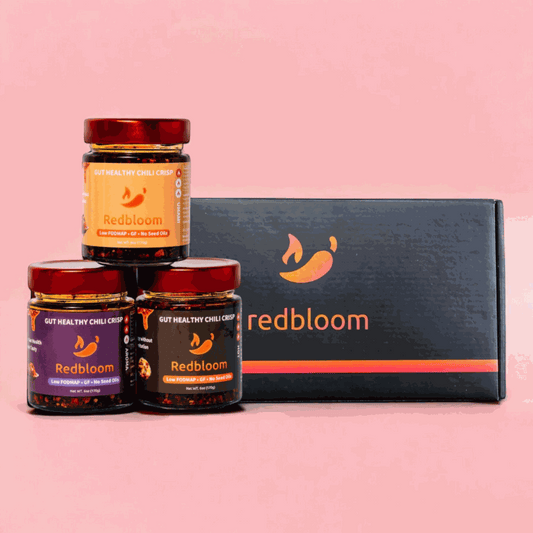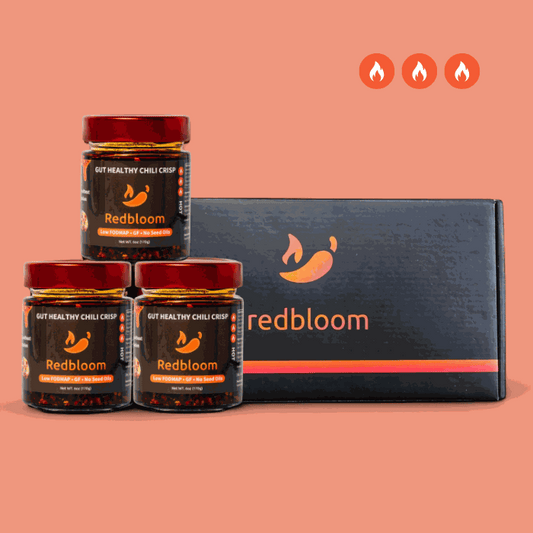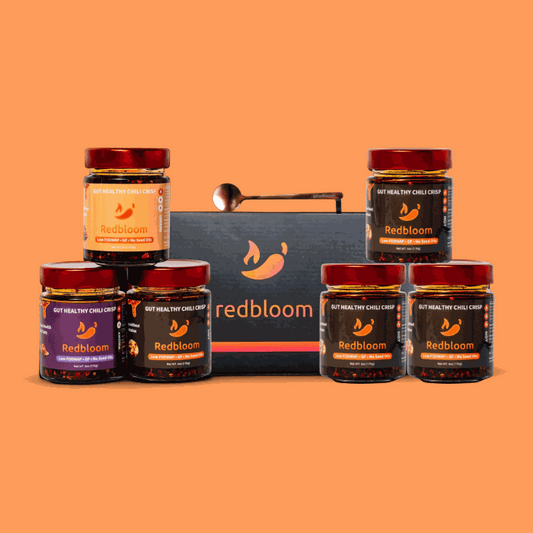Introduction
Let’s face it: being a student comes with enough stress without having to worry about gut problems. But if your stomach’s been grumbling—or worse—after meals, you're definitely not alone. College life often means late-night snacks, processed cafeteria food, and maybe even a bit too much hot sauce on that burrito. That’s where your gut health comes into play.
Your gut, or gastrointestinal system, isn’t just about digestion. It influences everything from your mood and energy levels to your immune system. For students especially, maintaining gut health can improve focus, reduce fatigue, and make long days on campus feel a little lighter.
Now, spicy foods—yes, we’re looking at you, chili crisp and chili oil—might taste like heaven, but for sensitive stomachs, they can spark symptoms like acid reflux, bloating, or that infamous burning sensation. That doesn’t mean you have to give them up, though. This blog walks through a full day of student-friendly, budget-conscious meals that support a happy gut—without skimping on flavor.
Understanding Gut Sensitivity
Gut sensitivity is more common than most students think. Whether it’s from stress, late-night eating, or high-capsaicin meals, the digestive system often takes a hit. Capsaicin, the compound that makes chili peppers spicy, can irritate the gut lining and stimulate acid production. While some people handle spice just fine, others feel like they swallowed fire [1].
Capsaicin activates TRPV1 receptors in the stomach, leading to increased acid secretion, burning sensations, and even nausea for those with existing sensitivities or conditions like IBS or gastritis [2].
Fortunately, foods rich in fiber, probiotics, and polyphenols can help soothe the digestive tract and build resilience in the gut microbiome [3].
Breakfast: Overnight Oats with Fruit and Seeds
Ingredients:
-
Rolled oats
-
Milk or plant-based milk
-
Chia seeds
-
Banana or berries
Overnight oats aren’t just Instagram-worthy—they’re a fiber-packed gut savior. The magic starts with oats, rich in beta-glucan, a type of soluble fiber that acts as a prebiotic. That means it feeds the good bacteria in your gut, encouraging a diverse and balanced microbiome [1].
Chia seeds enhance the fiber count, providing both soluble and insoluble types, which regulate digestion and help prevent constipation. They also contain omega-3 fatty acids, linked to lower gut inflammation [4].
Berries and bananas contribute natural sweetness and polyphenols, compounds known for their antioxidant and anti-inflammatory effects, helping reduce gut irritation [3].
Mid-Morning Snack: Yogurt Parfait with Berries and Nuts
Ingredients:
-
Plain Greek yogurt
-
Mixed berries
-
Walnuts or almonds
Greek yogurt delivers probiotics, the live bacteria that support your gut microbiome by improving the gut barrier and enhancing digestion [1].
Pair that with fiber-rich berries and nuts, and you've created a snack that supports both microbiome diversity and satiety. Almonds and walnuts add polyphenols and healthy fats, which help soothe the gut and improve nutrient absorption [5].
Avoid sugary, flavored yogurts, which can contain additives and sugars that may disrupt gut balance.
Lunch: DIY Burrito Bowl with Avocado and Beans
Ingredients:
-
Brown rice or quinoa
-
Black beans
-
Corn
-
Avocado
-
Salsa
-
(Optional) drizzle of chili oil or chili crisp
Brown rice and quinoa provide essential prebiotic fiber, which feeds good gut bacteria and helps regulate digestion [6]. Beans are packed with resistant starch, a superstar for feeding the microbiome.
Avocado brings in monounsaturated fats and soluble fiber—both excellent for calming the gut and promoting smooth digestion [4].
For a spicy twist, use milder chili oils or chili crisp. Look for versions made with neutral oils like avocado or olive oil. Capsaicin levels are lower in these varieties, and when paired with creamy avocado or grains, they’re much easier on the stomach [7].
Afternoon Snack: Peanut Butter-Banana English Muffin
Ingredients:
-
Whole grain English muffin
-
Natural peanut butter
-
Sliced banana
Whole grain breads provide insoluble fiber, great for digestion and microbiome support. Peanut butter (the natural kind) offers plant-based protein and healthy fats, which keep you full without taxing your digestive system.
Bananas bring in prebiotic fiber and pectin, which help soothe the stomach and aid in regular bowel movements [6].
Dinner: Veggie Stir-Fry with Tofu
Ingredients:
-
Mixed vegetables (broccoli, bell peppers, carrots)
-
Tofu
-
Garlic and ginger
-
Brown rice or rice noodles
A colorful stir-fry closes the day with a fiber and polyphenol-rich meal. Broccoli, carrots, and bell peppers reduce inflammation and improve microbiome diversity. Garlic and ginger have long been used for their digestive benefits—garlic acts as a prebiotic, while ginger soothes the gut and prevents nausea [5].
Tofu adds plant-based protein, while rice or noodles serve as a comforting, easy-to-digest base.
FAQs
1. Can I eat spicy food if I have a sensitive stomach?
Yes, in moderation. Choose lower-capsaicin chili oils and pair them with soothing foods like avocado or grains to minimize irritation.
2. Are probiotics essential for gut health?
They’re very beneficial. Foods like yogurt and fermented items support microbial diversity and improve digestion.
3. What should I avoid if I have gut sensitivity?
Heavily processed foods, too much spice, alcohol, and sugar can disrupt your microbiome and irritate the gut.
4. How do polyphenols help the gut?
They support microbial diversity and reduce inflammation, especially when found in berries, nuts, and colorful vegetables.
5. Can I maintain gut health on a student budget?
Absolutely. Affordable staples like oats, beans, bananas, yogurt, and rice can form the foundation of a gut-friendly diet.
Conclusion
Supporting your gut as a student doesn’t have to be complicated or costly. With fiber-rich breakfasts, probiotic-packed snacks, and balanced, spicy-smart meals, your digestive system can thrive. By understanding how foods like capsaicin impact gut sensitivity—and learning how to work around them—you can enjoy flavorful meals that actually help your body feel better, not worse.
References
[1] https://pmc.ncbi.nlm.nih.gov/articles/PMC10773664/
[2] https://pubmed.ncbi.nlm.nih.gov/36076980/
[3] https://pubmed.ncbi.nlm.nih.gov/38174551/
[4] https://zoe.com/learn/how-to-improve-gut-health
[5] https://www.sciencedirect.com/science/article/pii/S0002916523037188
[6] https://www.eatingwell.com/gallery/8049892/30-day-anti-inflammatory-gut-healthy-dinner-plan/
[7] https://www.healthline.com/health/gut-health





